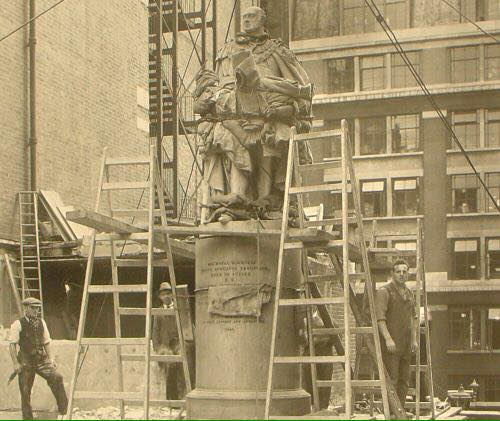En: The Duke of Sussex: Unterschied zwischen den Versionen
Keine Bearbeitungszusammenfassung |
K (Kategorie geändert) |
||
| (Eine dazwischenliegende Version desselben Benutzers wird nicht angezeigt) | |||
| Zeile 1: | Zeile 1: | ||
== The Duke of Sussex == | |||
[[Datei:Duke of sussex.jpeg]] | [[Datei:Duke of sussex.jpeg]] | ||
== The Hall in the Garden: The Duke of Sussex == | == The Hall in the Garden: The Duke of Sussex == | ||
Source: www.freemasonry.london.museum | |||
The Duke of Sussex, who had become Grand Master at the Union, died on 21st April 1843. It was decided a statue in Freemasons’ Hall would be the best tribute to him and one of the leading sculptors of the time – [[Edward Hodges Baily]] – was given the commission. Baily (a member of Jerusalem Lodge No 97) had just won second prize in the Nelson memorial competition and been allocated the figure of Nelson which was raised to the top of its column in Trafalgar Square in November 1843. | The Duke of Sussex, who had become Grand Master at the Union, died on 21st April 1843. It was decided a statue in Freemasons’ Hall would be the best tribute to him and one of the leading sculptors of the time – [[Edward Hodges Baily]] – was given the commission. Baily (a member of Jerusalem Lodge No 97) had just won second prize in the Nelson memorial competition and been allocated the figure of Nelson which was raised to the top of its column in Trafalgar Square in November 1843. | ||
| Zeile 8: | Zeile 13: | ||
The plans for the construction of the Masonic Peace Memorial Building after the 1914-1918 War had envisaged the retention of Sandby’s Hall and no thought had been given as to any need to accommodate the statue elsewhere. When the decision was taken to demolish this Hall due to structural weaknesses, the new Grand Temple had already been completed and a new location had to be found for the Duke’s statue. It is shown here during the demolition of the original Hall being moved to its new location in the ground floor corridor. Its base can sometimes be glimpsed in television programmes and films, which often use this area. | The plans for the construction of the Masonic Peace Memorial Building after the 1914-1918 War had envisaged the retention of Sandby’s Hall and no thought had been given as to any need to accommodate the statue elsewhere. When the decision was taken to demolish this Hall due to structural weaknesses, the new Grand Temple had already been completed and a new location had to be found for the Duke’s statue. It is shown here during the demolition of the original Hall being moved to its new location in the ground floor corridor. Its base can sometimes be glimpsed in television programmes and films, which often use this area. | ||
== See also == | |||
*[[En: Noble Freemasons]] | |||
{{SORTIERUNG:DukeofSussex}} | |||
[[Kategorie:Personalities|Duke of Sussex]] | |||
Aktuelle Version vom 9. Februar 2016, 12:39 Uhr
The Duke of Sussex
The Hall in the Garden: The Duke of Sussex
Source: www.freemasonry.london.museum
The Duke of Sussex, who had become Grand Master at the Union, died on 21st April 1843. It was decided a statue in Freemasons’ Hall would be the best tribute to him and one of the leading sculptors of the time – Edward Hodges Baily – was given the commission. Baily (a member of Jerusalem Lodge No 97) had just won second prize in the Nelson memorial competition and been allocated the figure of Nelson which was raised to the top of its column in Trafalgar Square in November 1843.
The Sussex statue was made of white Carrara marble and measured 7 feet (2.15m) high. It stood on a pedestal 6 feet 6 inches (2m) high and 3 feet 6 inches (1.1m) wide. On 29th April 1846 the Earl of Zetland unveiled the marble statue placed in the recess at the eastern end of Freemasons’ Hall, which had been built by Thomas Sandby in 1774-6.
The plans for the construction of the Masonic Peace Memorial Building after the 1914-1918 War had envisaged the retention of Sandby’s Hall and no thought had been given as to any need to accommodate the statue elsewhere. When the decision was taken to demolish this Hall due to structural weaknesses, the new Grand Temple had already been completed and a new location had to be found for the Duke’s statue. It is shown here during the demolition of the original Hall being moved to its new location in the ground floor corridor. Its base can sometimes be glimpsed in television programmes and films, which often use this area.

